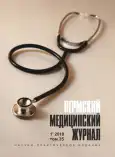Dynamics of life quality, anxiety and depression symptoms among patients with chronic insomnia in complex sanatorium-and-health resort treatment with inclusion of transcranial magnetotherapy
- Authors: Goryaev A.G.1,2
-
Affiliations:
- JSC “Health Resort Belokurikha”, Sanatorium “Siberia”
- Altai State Medical University
- Issue: Vol 35, No 1 (2018)
- Pages: 82-87
- Section: Articles
- URL: https://journals.rcsi.science/PMJ/article/view/8674
- DOI: https://doi.org/10.17816/pmj35182-87
- ID: 8674
Cite item
Full Text
Abstract
Aim. To evaluate the dynamics of the quality of life, symptoms of anxiety and depression in patients with chronic insomnia against the background of complex sanatorium-and-health resort treatment with inclusion of transcranial magnetotherapy (TCMT).
Materials and methods. 63 patients (mean age 53.1 ± 1.4 years) with verified diagnosis of chronic insomnia were examined. The patients were divided into 2 randomized groups by means of randomized sampling technique: 33 patients of the main group were administered a basic sanatorium complex including nitric-siliceous baths with low content of radon, massage of head and collar zone, terrencure, cognitive-behavioral therapy, group psychotherapy, transcerebral magnetotheprapy; 30 patients of the comparison group had the same therapy, but no TCMT.
Results. When analyzing the initial data before treatment, high levels of subclinical and clinically manifested anxiety and depression were revealed in all patients with insomnia. When comparing subjective complaints before and after treatment within both groups, a reliable dynamics in anxiety and depression assessment was detected. In the main group with TCMT used, the results of treatment were significantly better, than in the comparison group. In the comparison group, positive reliable dynamics of the quality of life indices was also noted, but it was statistically less significant by all scales, than in the main group.
Conclusions. Transcranial magnetotherapy, included into complex of sanatorium-and-health resort treatment of chronic insomnia patients, permits to reduce subjective clinical symptoms of anxiety and depression and improve patients’ quality of life, mostly of psychological component of their health status.
Full Text
##article.viewOnOriginalSite##About the authors
A. G. Goryaev
JSC “Health Resort Belokurikha”, Sanatorium “Siberia”; Altai State Medical University
Author for correspondence.
Email: tkulishova@bk.ru
аспирант кафедры поликлинической терапии и медицинской реабилитологии с курсом ДПО
Russian Federation, Belokurikha, BarnaulReferences
- Киштович А.В., Курбатова К.А. Методологические аспекты формирования и ведения базы данных в исследованиях качества жизни. Вестник Межнационального центра исследования качества жизни 2012; 19: 104–110.
- Ковров Г.В., Вейн А.М. Стресс и сон у человека. М.: Нейромедиа 2004; 324.
- Ковров Г.В., Лебедев М.А., Палатов С.Ю. Инсомния в амбулаторной практике. Медицинский совет 2013; 4: 24–30.
- Корабельникова Е.А. Психотерапия инсомнии: роль сомнолога и психотерапевта. Эффективная фармакотерапия. Неврология и психиатрия 2014; 12: 38–44.
- Кулишова Т.В., Пуценко В.А., Табашникова Н.А., Маслов Д.Г., Крахмелец Т.В. Психический статус у больных с различными заболеваниями в процессе общей магнитотерапии. Паллиативная медицина и реабилитация 2004; 2: 78–79.
- Левин Я.И. Инсомния: современные диагностические и лечебные подходы. М.: Медпрактика 2005; 427.
- Левин Я.И. Инсомния и ее лечение. Справочник поликлинического врача 2008; 4: 13-16.
- Морозова Л.Г., Посохов С.И., Ковров Г.В. Особенности субъективной оценки при нарушении качества сна и бодрствования у больных с психофизиологической инсомнией. Неврологический журнал 2011; 5: 30–34.
- Новик А.А., Ионова Т.И. Руководство по исследованию качества жизни в медицине. Под ред. акад. РАМН Ю.Л. Шевченко. 2-е изд. М.: ОЛМА Медиа Групп 2007; 320.
- Полуэктов М.Г. Современные представления о природе и методах лечения инсомнии. Российский физиологический журнал им. И.М. Сеченова 2012; 10: 1188–1199.
- Пономаренко Г.Н., Болотова Н.В., Райгородский Ю.М. Транскраниальная магнитотерапия. СПб.: Человек 2016; 152.
- Ширяев О.Ю., Рогозина М.А., Дилина А.М., Харькина Д.Н. Транскраниальная магнитотерапия непсихотических тревожных расстройств в психиатрической практике. Журнал неврологии и псиихатрии 2009; 5: 60–61.
- Шоломов И.И., Череващенко Л.А., Болотова Н.В., Манукян В.Ю. Транскраниальная магнитотерапия как метод коррекции вегетативных и адаптационных нарушений при хроническом утомлении. Журнал неврологии и психиатрии им. С.С. Корсакова 2010; 11: 55–56.
- Anderson L.H., Whitebird R.R., Schultz J. et al. Healthcare utilization and costs in persons with insomnia in a managed care population. Am. J. Manag Care 2014; 5: 157–165.
- Botteman M.F., Botteman M.F., Ozminkowski R.J., Wang S. et al. Cost effectiveness of long-term treatment with eszopiclone for primary insomnia in adults: a decision analytical model. CNS Drugs 2007; 4: 319–340.
- Léger D., Massuel M.A., Metlaine A. et al. Professional correlates of insomnia. Sleep 2006; 2: 171–178.
- Lichstein K.L., Taylor D.J., McCrae C.S. et al. Insomnia: epidemiology and risk factors. Principles and Practice of Sleep Medicine. 6th ed. Philadelphia: Elsevier 2016; 5: 761–768.
- The International classification of sleep disorders [Diagnostic and coding manual]. American Academy of Sleep Medicine. Darien 2014.
Supplementary files






